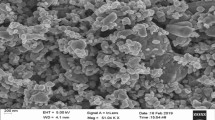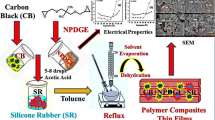Abstract
In this study, the dielectric properties of unfilled as well as nanofilled polystyrene-silicone rubber blends are evaluated. Accordingly, the preparation of polystyrene-silicone rubber blends is carried out considering three different concentrations of polystyrene (3, 7 and 10%wt). Also, the preparation of polystyrene-silicone rubber nanocomposites is carried out considering different two types of nanoparticles. These nanoparticle types are TiO2 and SiO2 with the same average particle size of 20 nm. Different nanoparticle concentration levels of 1.5, 2 and 3%wt are studied. The effect of thermal aging on the dielectric properties of unfilled as well as nanofilled polystyrene-silicone rubber samples is evaluated. The samples are subjected to thermal aging for two months at a temperature of 130 °C. The average breakdown strength as well as the breakdown strength at 10% and 50% probabilities is evaluated before and after the thermal aging process. The dielectric response includes relative permittivity and dissipation factor which measured and evaluated under thermal aging. The obtained results show that adding small amount of polystyrene to silicone rubber improves its dielectric properties. Finally, adding small amounts of TiO2 and SiO2 nanoparticles to polystyrene-silicone rubber blends give more improvements in its dielectric properties.



















Similar content being viewed by others
Data availability
This declaration is not applicable.
References
Zhou Y, He J, Hu J, Huang X, Jiang P (2015) Evaluation of polypropylene/polyolefin elastomer blends for potential recyclable HVDC cable insulation applications. IEEE Trans Dielectr Electr Insul 22:673–681
Hosier IL, Vaughan A, Swingler SG (2010) An investigation of the potential of ethylene vinyl acetate/polyethylene blends for use in recyclable high voltage cable insulation systems. J Mater Sci 45:2747–2759
Prabu RR, Usa S, Udayakumar K, Khan MA, Majeed SSMA (2007) electrical insulation characteristics of silicone and EPDM polymeric blends. I. IEEE Trans Dielectr Electr Insul 14(5):1207–1214. https://doi.org/10.1109/TDEI.2007.4339481
Sugumaran CP (2013) Diagnosis on mechanical and electrical properties of cable insulation PVC with nanofiller. In: IEEE 1st international conference on condition assessment techniques in electrical systems (CATCON), Kolkata, India
Malysheva T, Tolstov A (2022) Impact of interface interactions on a s tructure formation of t he nanostructured poly(urethane-urea) - poly(vinyl chloride) blends filled with modified N anosilica. In: IEEE 12th International C onference Nanomaterials: Applications and Properties (NAP)
Sugumaran CP (2015) Experimental study on dielectric and mechanical properties of PVC cable insulation with SiO2/CaCO3 nanofillers. In: IEEE Conference on Electrical Insulation and Dielectric Phenomena, Ann Arbor
Abdel-Gawad NM, Mansour D-EA, El Dein AZ, Ahmed HM, Darwish MM (2016) Effect of functionalized TiO2 nanoparticles on dielectric properties of PVC nanocomposites used in electrical insulating cables. In: Eighteenth International Middle East Power Systems Conference (MEPCON)
Andrei L, Ciuprina F (2021) Temperature influence on electrical conductivity of PVC-TiO2 Nanocomposites. In: 9th International Conference on Modern Power Systems (MPS)
Mohamed EI, Mahmoud AT, Mohamed AI, Amr MA-E (2022) Effect of external electric field during sample preparation on dielectric properties of PVC nanocomposites. Electr Eng. https://doi.org/10.1007/s00202-022-01708-z
Tagami N, Okada M, Hirai N, Ohki Y, Tanaka T, Imai T, Harada M, Ochi M (2008) Dielectric properties of epoxy/clay nanocomposites—effects of curing agent and clay dispersion method. IEEE Trans Dielectr Electr Insul 15(1):24–32
Yun G, Sun Y, Xiao F, Moon K-S, Wong CP (2007) Effect of silica on the non-linear electrical property of polymer composites. In: 12th International Symposium on Advanced Packaging Materials: Processes, Properties, and Interfaces
Qi W, Zhe L, Jiandong W, Yi Y (2012) The thermal conductivity and electrical strength of epoxy resin with different filler content of micro and nano alumina. In: IEEE International Conference on Condition Monitoring and Diagnosis
Wang Y, Wang C, Zhang Z, Xiao K (2017) Effect of nanoparticles on the morphology, thermal, and electrical properties of low density polyethylene after thermal aging. Nanomaterials 7(10):320
Rahim NH, Lau KY, Kamarudin SN, Muhamad NA, Mohamad N, Rahman WA (2018) Effect of nanofiller calcination on breakdown performance of Zirconia based polyethylene nanocomposites. In IEEE 7th International Conference on Power and Energy (PECon)
Peng S, He J, Hu J, Huang X, Jiang P (2015) Influence of functionalized mgo nanoparticles on electrical properties of polyethylene nanocomposites. IEEE Trans Dielectr Electr Insul 22(3):1512–1519
Fuse N, Kozako N, Tanaka T, Ohki Y (2005) Effects of mica fillers on dielectric properties of polyamide nanocomposites. In: CEIDP ’05. Annual Report Conference on Electrical Insulation and Dielectric Phenomena
Fu Y, Wang Y, Wang S, Gao Z, Xiong C (2018) Enhanced breakdown Strength and energy storage of pvdf-based dielectric composites by incorporating exfoliated mica nanosheets. Polym Compos 40(5):2088–2094
Nagachandrika P, Sarathi R, Sridharan K (2022) Characterization of silicone rubber/MgO nanocomposites for grippers in transmission line inspection robots. IEEE Trans Nanotechnol. https://doi.org/10.1109/TNANO.2022.3221493
Mohamed EI, Elsayed TE, Safaa FE, Mohamed AI, Amr MA-E (2022) The role of the accumulated surface charge on nanoparticles in improving the breakdown strength of liquid and solid insulation. Energies 15(13):4860. https://doi.org/10.3390/en15134860
Bazli L et al (2021) Electrical properties of polymer blend composites based on silicone rubber/EPDM/clay hybrid for high voltage insulators. J Compos Compd 3(6):18–24
Shikaleska AV, Pavlovska FP (2012) Advanced materials based on polymer blends/polymer blend nanocomposites. In: International Conference on Structural Nano Composites (NANOSTRUC 2012)
Tanaka T (2005) Dielectric nanocomposites with insulating properties. IEEE Trans Dielectr Electr Insul 12(5):914–928
Mohamed MH, Amr MA-E, Elsad RA, Mohamed AI (2019) Performance of PVC/SiO2 nanocomposites under thermal ageing. Appl Nanosci J. https://doi.org/10.1007/s13204-018-00941-y
Hu B, Zhong L, Ma S, Wang P, Xu C (2006) Study on dielectric behaviors of PMMA during thermal aging. In: IEEE 8th International Conference on Properties and Applications of Dielectric Materials. https://doi.org/10.1109/icpadm.2006.284291
Zhenzhen O, Feng G, Huaijun Z, Shumeng D, Lingjian Z (2019) Research on the thermal conductivity and dielectric properties of AlN and BN co-fi lled addition-cure liquid silicone rubber composites. RSC Adv. https://doi.org/10.1039/c9ra04771a
Funding
No funding is applicable.
Author information
Authors and Affiliations
Contributions
AMA-E, MEI and AS wrote the main manuscript text and Amira Sleet prepared figures. All authors reviewed the manuscript
Corresponding author
Ethics declarations
Conflict of interest
The authors declare no competing interest.
Ethical approval
This declaration is not applicable.
Additional information
Publisher's Note
Springer Nature remains neutral with regard to jurisdictional claims in published maps and institutional affiliations.
Rights and permissions
Springer Nature or its licensor (e.g. a society or other partner) holds exclusive rights to this article under a publishing agreement with the author(s) or other rightsholder(s); author self-archiving of the accepted manuscript version of this article is solely governed by the terms of such publishing agreement and applicable law.
About this article
Cite this article
Abd-Elhady, A.M., Sleet, A.Y., Izzularab, M.A. et al. Polystyrene/silicone rubber blends with improved dielectric properties. Electr Eng 105, 1669–1681 (2023). https://doi.org/10.1007/s00202-023-01756-z
Received:
Accepted:
Published:
Issue Date:
DOI: https://doi.org/10.1007/s00202-023-01756-z




